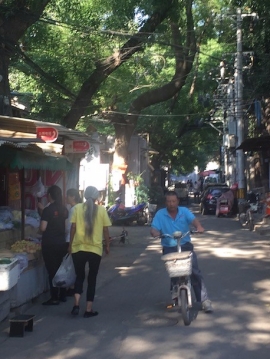
Before our trip to Asia, I read Paul French’s Midnight in Peking, about the unsolved murder of a young British woman in prewar Peking. Much of the shadier action in that book takes place in the city’s hutongs, a type of narrow street or alley commonly associated with northern Chinese cities, especially Beijing.
Our first afternoon in Beijing my husband got an alert about an “FTF” (first to find) opportunity. A new geocache had been published in the city, but not found yet. Geocaches are relatively rare in China in the first place, and this author makes the point that you are trying to find those few caches amidst a billion muggles.
Another problem with geocaching in China is the “great firewall.” Google maps, Apple maps, and the geocaching apps that are based on them, do not work there. If you try to use one of these internet maps, it has an offset. For example, my app, Cachly, showed the cache almost 0.3 miles from its true location.

Fortunately, when the subject is geocaching, my husband is prepared. Before we left he did some research, and found that OpenStreetMaps, with user-created data, would still work in China. See this discussion thread for more details about the problems with using online maps in China. No matter what map we were using, however, we were directed around the main train station, and that meant hutongs! We set off. This would be a feather in our cap: two Anglos from California get an FTF in Beijing!
The first doors as we approached the station did look a little sketchy. The air wasn’t too bad, we could see blue sky, but the weather was still very hot and dusty. Many people were riding scooters and they could be seen parked outside.
People were friendly and one tried to help but didn’t speak English. They seemed bemused more than anything else by foreigners wandering around outside the station looking at their phones. They were less amused when we tried to buy water with a 100-Yuan note. And I don’t think we wanted to see what this public bathroom looked like on the inside.

As we went on, we started to see more welcoming storefronts and doors.
Eventually, all our water already gone, we did get to the park where the cache was to be found. More doors next week!
This post is for Norm 2.0’s Thursday Doors, a weekly feature allowing door lovers to come together to admire and share their favorite door photos from around the world. I’ll be sharing doors from my recent trip to East Asia for the next several Thursdays.










Some interesting doors finds. Sounds like quite an adventure trying to circumvent their internet restrictions.
LikeLiked by 1 person
Gosh, a whole new world, I must get tech-savvy re geocaching…what a wonderful way to explore, thanks for the info and the very interesting post!
LikeLiked by 1 person
Good grief! That’s quite a book to read just before going there and knowing you’d likely be exploring through them!
LikeLiked by 1 person
A friend recommended it. I do like reading books about a place before I visit.
LikeLiked by 1 person
You have to have been in China to see a real hutong!
My amazement was about the people who live in there looked middle class because of their clothes, but when you know a whole family lives n one room without a bathroom, and that there’s a community bath house, you’re transported back 50 years ago (I only saw it, because the toilet in our hotel around the corner didn’t work, and the staff advised us to go there).
Yeah, big fire walls in any country with a communistic regime… although many young people there, are internet savvy enough to find ways around it:):)
LikeLiked by 1 person
Yep, my first time in China!
LikeLike
Were you in Beijing, or also other cities? We traveled together with my son who at that time was teaching English. We wouldn’t have made it without him! By the way, what does VPN stand for?
LikeLiked by 1 person
Yes, we were in Beijing and also Shanghai and Xian. (I have some more doors from those places!)
LikeLike
We were also in Nanchang (12 hrs. W from Shanghai, Quang Zhou, and Zhen-Zhen. Am looking forward to see those doors:)
LikeLiked by 1 person
VPN stands for virtual private network. There are apps you can download that will set up a VPN for you and that can circumvent the firewall.
LikeLike
Thank you for the info, I might need it in the future!
LikeLiked by 1 person
You can get around the firewall for google and facebook by using VPN, but I just read the government is cracking down on VPNs.
LikeLike
What an adventure!
LikeLiked by 1 person